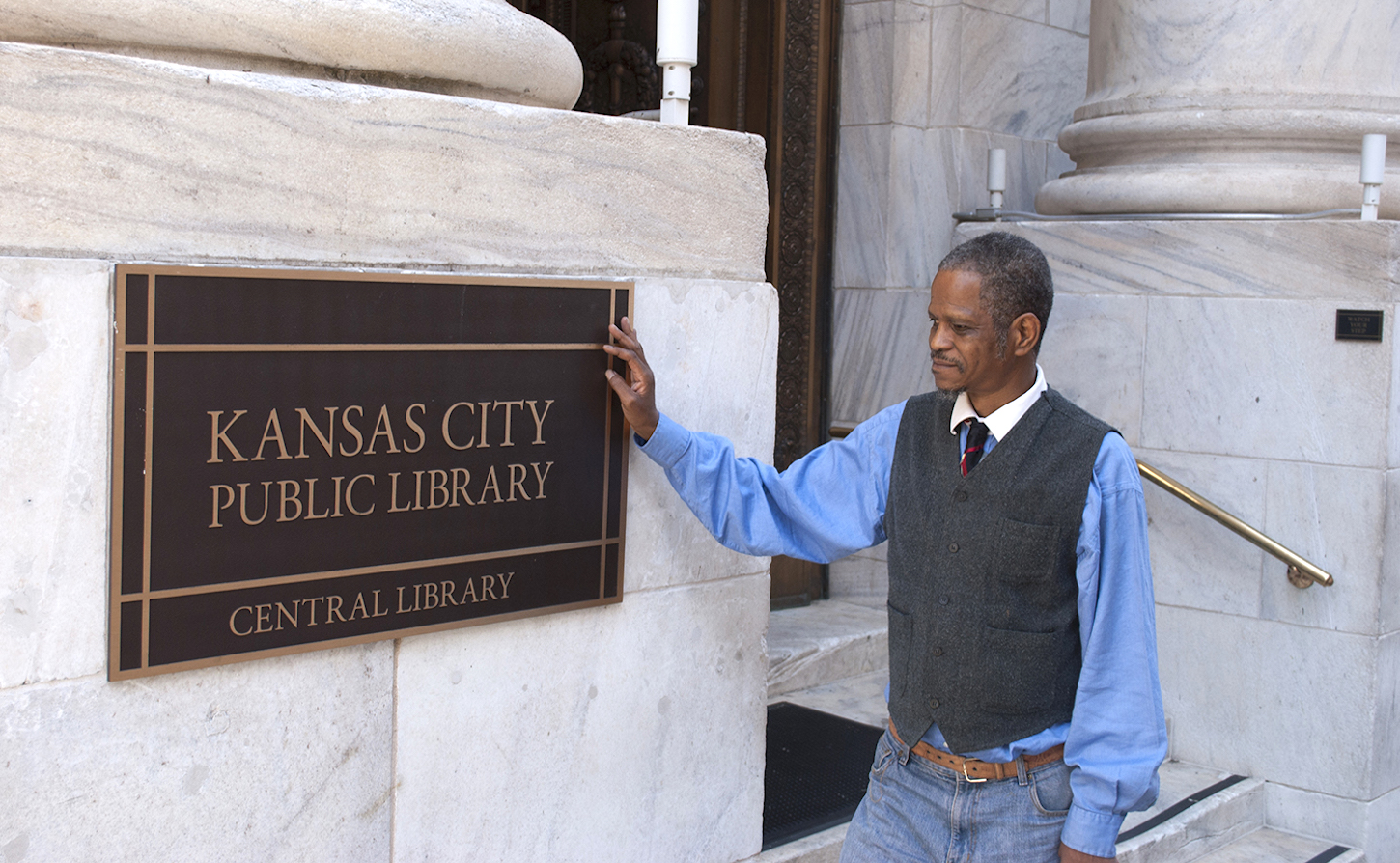The Tree and the Tooth
A pilgrimage to Sri Lanka’s Buddhist capitals The post The Tree and the Tooth appeared first on Tricycle: The Buddhist Review.
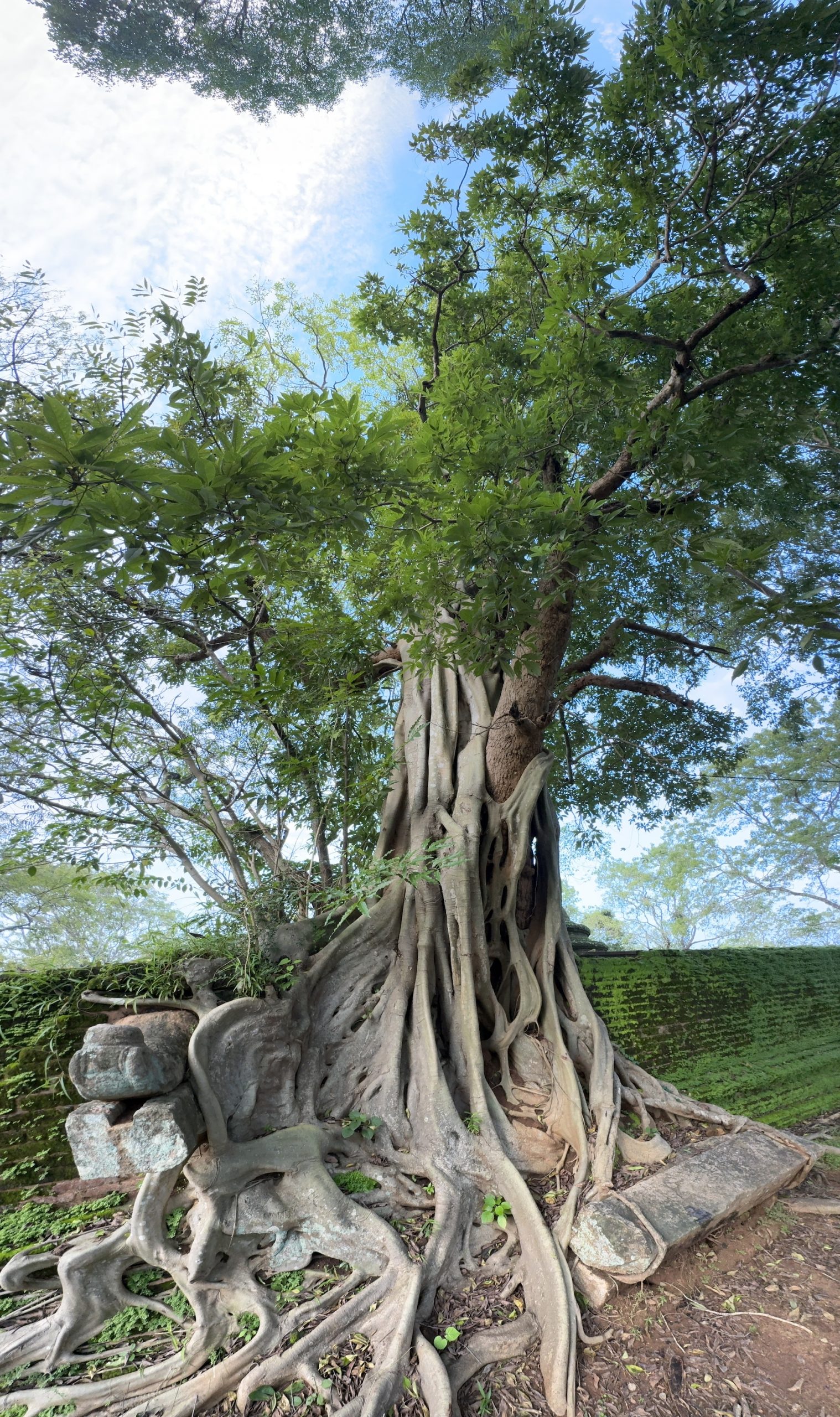
We can’t drink the water, but we can breathe the air. Breathing in short, we know we are breathing in short. Breathing out short, we feel like we’re hyperventilating, because we’re wearing masks. We are purifying, sanitizing, and sterilizing. We drink bottled water, and even brush our teeth with it, but here in Sri Lanka, we are the foreign body, the invasive species threatening to throw the ecosystem out of balance. We have come bearing COVID, seeking Instagrammable photos, as our ancestors sought cinnamon, pepper, tea, and rubber. Like the distinguished visitors of ancient times—the monkey god Hanuman, the Buddha himself, and King Ashoka’s son Mahinda—we come and go by air, via Doha, Dubai, Singapore.
We sit in a hotel in the forest outside Anuradhapura, Sri Lanka’s ancient capital. 6:30 a.m. A dozen or so pilgrims from a group of twenty-four, sponsored by Tricycle, settle in for morning meditation on a rainy day—it’s our privilege to have forgotten what day it is. Light and heat fill the room, which has no walls, as we sit for thirty minutes (we’re in the present moment, but breakfast is at 7:00). Experiencing the sweating body, we breathe in. Experiencing the sweating body, we breathe out. The sounds of the forest envelop us: the hoot of the monkey, the croak of the frog, the mournful call of the peacock, and, much closer, in the room, just behind our ears, the shrill whine of the mosquito.
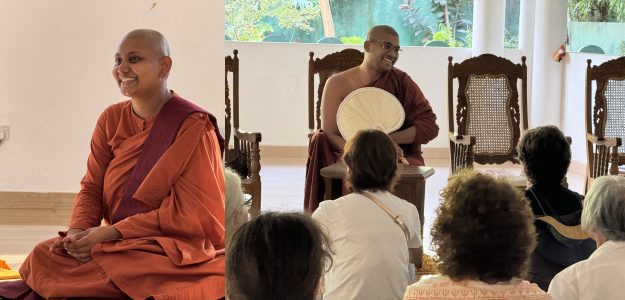 Sayalay Nirasa (left) and Ven. Medhankara (right).
Sayalay Nirasa (left) and Ven. Medhankara (right).Practicing with mosquitoes has a long and distinguished pedigree. Their exquisitely refined capacity to pierce thin veils of equanimity has been treasured by generations of Buddhists. The Buddha himself was not much bothered by mosquitoes, nor did he advise others on how to tolerate them, perhaps because there is nothing to say. There is the meditator and there is the mosquito—or mosquitoes, emphatically plural.
“There are hardly any mosquitoes in Sri Lanka,” we are gently told, but Google suggests a robust cohort of 150 different species. A meditator counts nine new bites after the half-hour sit, the back of his hand a Martian landscape of red bumps.
But the pilgrims, shielded by hats, sunglasses, and sunscreen, move out into the sunlight, which mosquitoes sagely avoid.
We are here to visit the Buddhist sites of three of the island’s former capitals, Anuradhapura (4th century BCE to 11th century CE); Polonnaruwa (11th to 13th centuries CE); and Kandy (15th to 19th centuries). It is poignant to note that in Sri Lanka, the oldest Buddhist civilization still in existence, the great Buddhist monuments are in ruins, and further, that in each successive stage of history the Buddhist centers diminish in scale.
Anuradhapura, the site of Sri Lanka’s largest stupas (reliquary mounds), is now a vast field of low stone walls and brick-colored sand in the process of turning back into a forest. Once a great city, it supported vast monasteries housing thousands of monks alongside palaces, artificial lakes, and gardens. (“Sri Lanka has no natural lakes,” a guide tells the pilgrims. Impossible! Yet apparently true.) This is the “dry zone,” and massive irrigation works, their remnants still visible, rerouted and stored water for the city to use when the rains paused. (It is also, in January, the “dry season,” though on this pilgrimage it has rained every day.) A modern town built by the British is nearby, but the ancient city still lives, because at all hours it is filled with the footsteps and flowers of devotees, who travel from across the island to see the stupas and Buddhas—the so-called Samadhi Buddha is much admired—and most of all, the Bodhi tree.
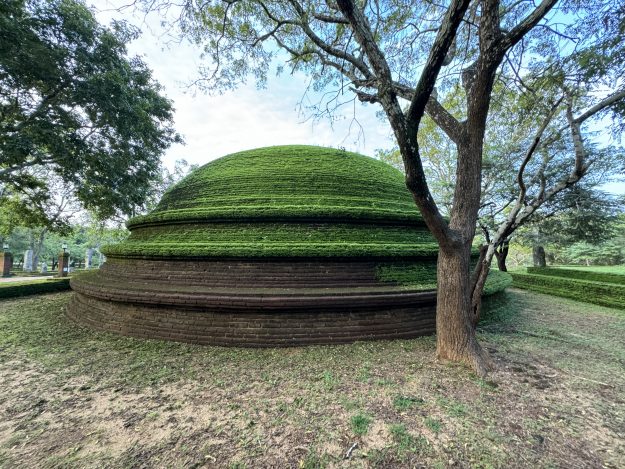 Stupa, Anuradhapura, Sri Lanka.
Stupa, Anuradhapura, Sri Lanka.The Jaya Sri Maha Bodhi (“Jaya, Sri, Maha” are all honorifics speaking to its importance—victorious, resplendent, great) was the first Bodhi tree in Sri Lanka, said to be a cutting from the original, in Bodh Gaya, India, and delivered by the nun Saṅghamitta, Ashoka’s daughter, in 236 BCE. Or was it 288? Accounts differ. The current tree in Bodh Gaya is reputedly a cutting from the Anuradhapura tree. Along with Sri Pada, or Adam’s Peak, the sacred mountain with a footprint said to be the Buddha’s on the summit, and the temple of the tooth relic in Kandy, the Bodhi tree in Anuradhapura is the island’s most venerated Buddhist site.
While cuttings from the Bodhi tree (a variety of fig tree, Ficus religiosa) exist all over the world, and Bodhi trees exist at many of the most important Buddhist pilgrimage sites, the centrality of Bodhi tree devotion seems to be unique to Sri Lankan Buddhism. Across the island, it is the Bodhi trees that devotees appeal to for rain, for good harvests, for healing, for good fortune, and to bless their yet-to-be-born children. The trees, twenty-eight or so, are all said to be cuttings from the Anuradhapura tree, and collectively define the island’s sacred landscape. Buddhist sites of any significance contain either a living Bodhi tree or a marker saying where their Bodhi tree used to stand.
Sacred tree sites have an offering table where, for a small fee, devotees can pour a cup or pitcher of water on the roots of the tree, or, if the fence prevents getting that close, on the ground as close as possible to the tree’s base. The very leaves and branches, carefully tended and watered with many offerings, can offer Buddhist pilgrims a living link to the historical Buddha.
Four massive stupas (and innumerable small ones) also remain. Two have been refaced with white plaster, while the others remain naked brick. All are among the largest brick structures in the world. The Ruwanwelisaya stupa, one of the restored stupas, is lit up and shines brightly at night. We pilgrims joined the many families who, despite steady rain, circumambulated and offered flowers at the altars surrounding the massive white dome, which is said to house a large quantity (“two quarts”) of the Buddha’s relics.
Following the families in white linen, we bow, we place flowers on tables, and we sit on mats cut from car seats to keep our Western bottoms dry. When we sit in meditation, the posture and practice is itself the realization of enlightenment. When we offer flowers and bow, taking the posture of devotion, this is the realization of true devotion.
Anuradhapura suffered a series of invasions that eventually drove the court to Polonnaruwa, a military outpost turned royal resort sixty-five miles south and east, farther from South India, from which waves of invasions came. (Sri Lanka is moving away from India at the rate of one centimeter a year—far too slow.) The fall of Anuradhapura also brought about the end of the bhikkhuni order in Sri Lanka, and reintroducing ordination remains a contested issue. Though nuns are present in Sri Lanka, sometimes in large and thriving monastic centers, they refer to themselves using other terms such as sayalay, the Burmese term for a novice nun, rather than bhikkhuni.
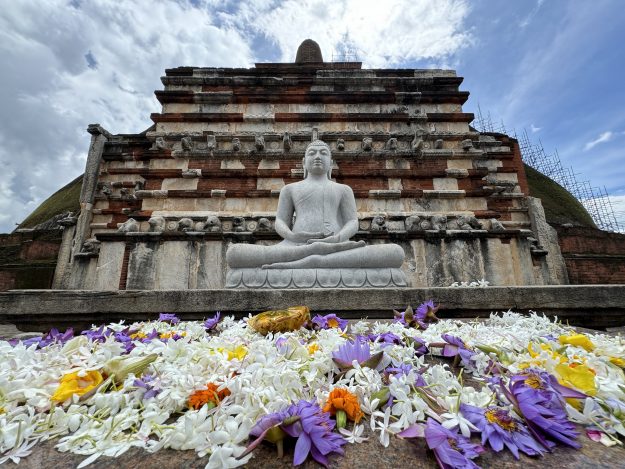 Polonnaruwa, Sri Lanka.
Polonnaruwa, Sri Lanka.Polonnaruwa, the medieval capital, developed along a broad lakefront, and its ruins are still cooled by lacustrine breezes. Its stupas are smaller, its monastics fewer. The buildings were less grand, but its surviving Buddhas, particularly those at Gal Vihara, meaning “rock temple,” are among the most graceful in the world. Images of these statues are probably familiar to many Buddhists, whether or not they know where the stones themselves lie.
Conforming to the shape of the lined granite cliff, the statues are spare and without ornament, though said to have once been sheathed in hammered gold. Trappist monk Thomas Merton wrote of them, “I am able to approach the Buddhas barefoot and undisturbed, my feet in wet grass, wet sand. Then the silence of the extraordinary faces. The great smiles. Huge and yet subtle. Filled with every possibility, questioning nothing, knowing everything, rejecting nothing.” A week after this sublime viewing, Merton was found dead in Bangkok.
Polonnaruwa was destroyed, as Anuradhapura was. The final destruction was achieved, according to Sri Lankan chronicles, by Magha, meaning “the magnificent,” said to be from Kalinga, in eastern India.
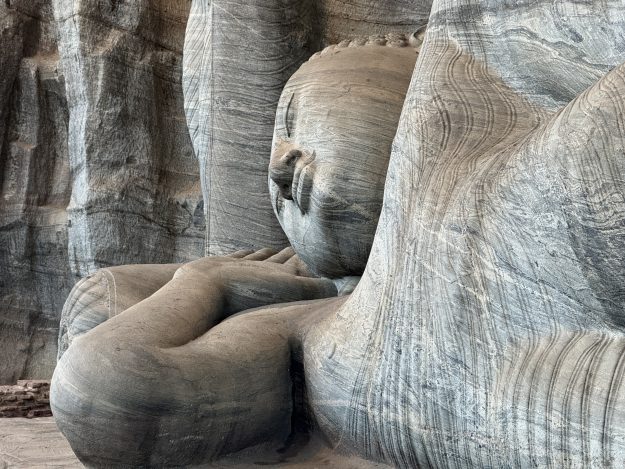 Gal Vihara, Sri Lanka.
Gal Vihara, Sri Lanka.Kalinga holds a curious place in Buddhist history, and more particularly Sri Lankan history. The area was conquered by Ashoka in 250 BCE, and the extraordinary violence of the battle is said to have led to his conversion to Buddhism. Two of Ashoka’s children are responsible for bringing Buddhism to Sri Lanka, according to local lore. What a painful irony, then, that 1,500 years later, a conqueror from this region would lay waste to Sri Lanka and nearly extinguish the dharma on the island. The decline was so severe that though lay devotion continued, the sangha required resuscitation from Burma and Thailand, and the major Buddhist sites fell into disrepair and remained overgrown for centuries.
The destruction of Polonnaruwa led to a decentralization of authority and an elevation of veneration for the tooth relic, Sri Lanka’s locus of temporal power. Whoever holds the tooth symbolically holds sovereignty over the island. Strangely enough, the tooth also came to Sri Lanka from Kalinga, in the 4th century CE, in the hair of a princess named Hemamali, which means “golden garland.”
Said to be the tooth of the historical Buddha, the relic was housed in Anuradhapura, then Polonnaruwa, then a succession of minor capitals before arriving in 1595 in Kandy, 500 meters up in the mountains and chosen for its isolation and distance from both South India and the Portuguese, who by now controlled the island’s ports. (The Portuguese at one point sneaked into Kandy and made off with the tooth and took it to Goa, where the archbishop ritually pulverized it and burned the dust, but the tooth miraculously reappeared in Sri Lanka—or, as some Sri Lankans say, the Portuguese stole a fake.) The Dutch wrested the ports and the cinnamon trade from the Portuguese, but the Kandyan kingdom, in possession of the tooth, would outlast them both and endure until the English arrived in 1815. The English cut a pass through the mountains, connecting Kandy with the port of Colombo, ending the last Sri Lankan kingdom’s political independence. They then planted tea everywhere and are still drinking it today.
On the road to Kandy from the northern capitals are the Dambulla caverns, Sri Lanka’s largest Buddhist cave complex. Painted Buddhas cover every inch of the walls and ceilings of this complex, and Buddha statues line the walls. Buddhists once demurred from portraying the Buddha at all, but in Dambulla there is an almost frenetic need to present him. He appears in row after row, identical yet multiple. The Sri Lankan Buddhism of this stage, the 14th century, shows Mahayana and Hindu influence in its visual forms, and more to the point, an anxiety about Buddhism’s place in Sri Lanka and the world beyond.
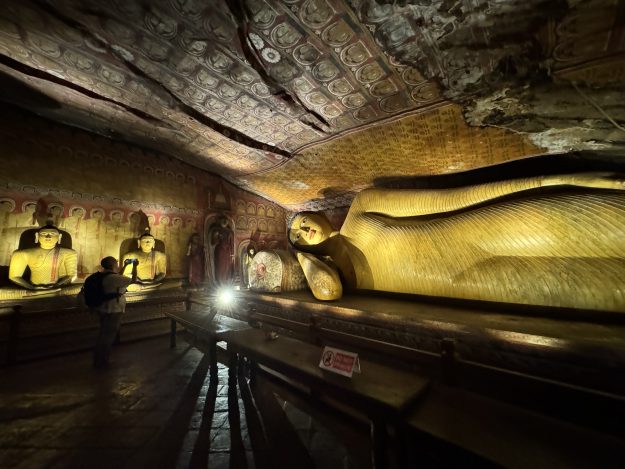 Dambulla, Sri Lanka.
Dambulla, Sri Lanka.Down the road from Dambulla is Aluvihara, a monastery perched amid towering boulders where, according to Sri Lankan accounts, the Pali canon was first committed to palm leaves in the 1st century BCE. None of these ancient etchings (the palm leaf is first carved, then ink is applied to stain the exposed flesh) remain. Aluvihara’s current library is sparsely furnished, with a glass case displaying examples of more recent palm leaf writings. The previous library is known to have housed a large repository of Pali manuscripts dating back to antiquity, but the British burned it during the Matale rebellion in 1848, a tumultuous year of world revolution. The Buddhist scholar Buddhaghosa (4th to 5th century CE) had a cave here, which is preserved for visitors.
The pilgrims finally arrive in the city of Kandy, built around a lake in a mountain valley. Its main Buddhist attraction is the current temple of the tooth, a medieval shrine around which was constructed a larger building that, from a distance, resembles a posh country club. The tooth itself is kept in a “casket,” or series of chests inside a sealed room. The window to this room is opened twice a day, and the casket within can be glimpsed for a second or two by a crowd that, pushing and shoving with a palpable lack of equanimity, jostles past.
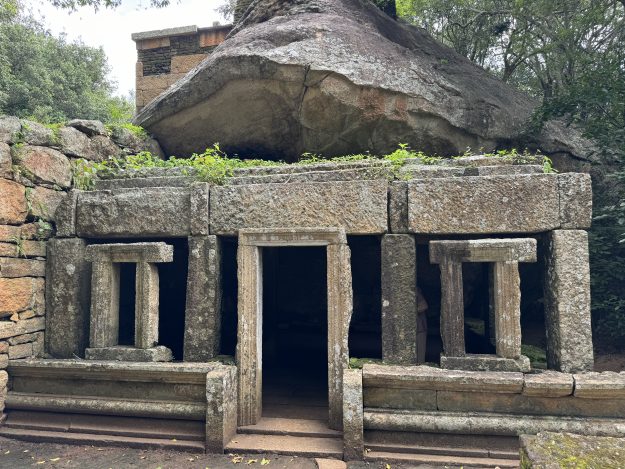 Alu Vihara, Sri Lanka.
Alu Vihara, Sri Lanka.There is no Bodhi tree at the temple of the tooth. Was there, once? But there is one in the hotel courtyard, and we are drawn to sit facing it. The pilgrims visited the temple in the dark of early morning on their last day on the island. Soon after, it was back to Doha, Dubai, and Singapore, and then on to home, wherever it might be found. Each hoped that they, like the tooth, might one day serendipitously find their way back to Sri Lanka.
Photos by BJ Graf

 Koichiko
Koichiko 








